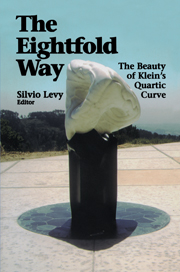Book contents
- Frontmatter
- Contents
- Preface: MSRI and the Klein Quartic
- The Eightfold Way: A Mathematical Sculpture by Helaman Ferguson
- The Geometry of Klein's Riemann Surface
- The Klein Quartic in Number Theory
- Hurwitz Groups and Surfaces
- From the History of a Simple Group
- Eightfold Way: The Sculpture
- Invariants of SL2(𝔽q) . Aut(𝔽q) Acting on ℂn for q = 2n ± 1
- Hirzebruch's Curves F1 , F2 , F4 , F14 , F28 for Q(V7)
- On the Order-Seven Transformation of Elliptic Functions
The Geometry of Klein's Riemann Surface
Published online by Cambridge University Press: 25 June 2025
- Frontmatter
- Contents
- Preface: MSRI and the Klein Quartic
- The Eightfold Way: A Mathematical Sculpture by Helaman Ferguson
- The Geometry of Klein's Riemann Surface
- The Klein Quartic in Number Theory
- Hurwitz Groups and Surfaces
- From the History of a Simple Group
- Eightfold Way: The Sculpture
- Invariants of SL2(𝔽q) . Aut(𝔽q) Acting on ℂn for q = 2n ± 1
- Hirzebruch's Curves F1 , F2 , F4 , F14 , F28 for Q(V7)
- On the Order-Seven Transformation of Elliptic Functions
Summary
Starting from the hyperbolic definition ofKlein's surface we prove platonicity, derive thetwo classical equations W7 = Z(Z -1)2 between meromorphic functions andx3y+y3z+z3x = 0 between holomorphic forms,describe a pair of pants decomposition in terms ofwhich the automorphisms can be seen, find a basisfor the holomorphic forms for which all periods(hence the Jacobian) can be computed, and fromwhich the lattice of rhombic tori can bedetermined which are covered by Klein'ssurface.
1. Introduction
In autumn 1993, in front of the MSRI in Berkeley, amarble sculpture by Helaman Ferguson called The Eightfold Way wasrevealed. This sculpture shows a compact Riemannsurface of genus 3 with tetrahedral symmetry andwith a tessellation by 24 distorted heptagons. Thebase of the sculpture is a disc tessellated byhyperbolic 120°-heptagons, thus suggesting that oneshould imagine that the surface is “really”tessellated by these regular hyperbolic polygons. Inthe celebration speech Bill Thurston explained howto see the surface as a hyperbolic analogue of thePlatonic solids: Its symmetry group is so large thatany symmetry of each of the 24 regular heptagonsextends to a symmetry of the whole surface - a factthat can be checked “by hand” in front of the model:Extend any symmetry to the neighboring heptagons,continue along arbitrary paths and find that thecontinuation is independent of the chosen path. Thehyperbolic description was already given by FelixKlein after whom the surface is named.
Information
- Type
- Chapter
- Information
- The Eightfold WayThe Beauty of Klein's Quartic Curve, pp. 9 - 50Publisher: Cambridge University PressPrint publication year: 1999
Accessibility standard: Unknown
Why this information is here
This section outlines the accessibility features of this content - including support for screen readers, full keyboard navigation and high-contrast display options. This may not be relevant for you.Accessibility Information
- 1
- Cited by
